2000 BC - 0 AD
Gold foils
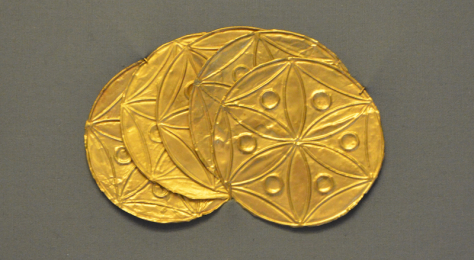
Mycenaean funerary gold foil attachments with six-petal rosette geometry found from the Archeological Museum of Istanbul. Mycenae, Greece, 1600 BC. (Photo © Marko Manninen)
Cosmetic box
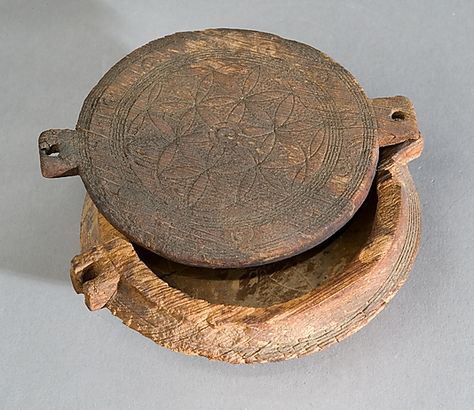
A circular wooden cosmetic box with a swivel lid1 in the The Metropolitan Museum of Art in New York. Thebes, Egypt, 1492 - 1473 BC.
This box has a swivel top incised with a decorative pattern of concentric and overlapping circles that must have been made with an early version of a drawing compass.
Resembling 12 petal rosette in the ivory box2 1550 BC and 32 rays straight line star can be found from the same period. (Photo © MET)
Silver goblet

A silver goblet3 in the museum of Louvre. The underside of the object was unreachable for the visitors because the goblet stands on the thick basement. But the picture in the object description shows a full Flower of Life pattern in the bottom, very much similar to the silver goblet underside decoration in Stockholm. Unfortunately, only very little is known about the Marlik culture4, but artifacts found from the royal cemetery shows excellence in the gold and silver metalwork. Marlik, northern Iran, 1400 – 1100 BC. (Photo © Marko Manninen)
Silver gazelle cup
The base of the silver gazelle cup5. From the Safid River region, Iran, 1000 BC.
Golden goblet
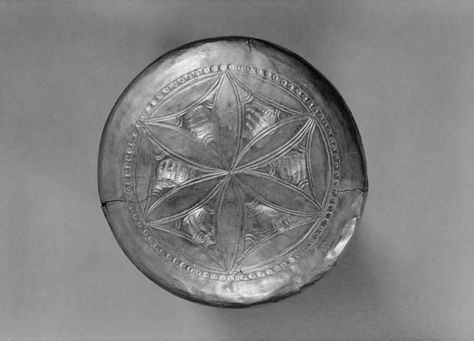
The underside of a golden goblet6 in the museum of Louvre. Excavation report7 shows several artifacts having similar six-petal rosettes with surrounding petals (or larger rosette nets) under the goblets and beakers. Marlik, Iran, 1400 – 1100 BC. (Photo © 1985 Photo RMN / Pierre et Maurice Chuzeville)
Ivory whorl

This artifact was categorized as a local object from the sanctuary of Aphrodite. It is visible in the Museum of Palaipafos (Kouklia, Cyprus). Dating is mentioned between 1600 - 1100 BC making it one of the oldest FOL found from the Mediterranean world.
Similar ivory whorls8 can be seen in the British Museum. They are also from Cyprus, 1340 - 1050 BC. Note how peripheral petals are rough and made probably by hand. This is a good example how much precise work it takes to draw the whole FOL pattern after the first seven simple circles. (Photo © Marko Manninen)
Phoenician bronze bowl
A Phoenician bronze bowl9 in the Los Angeles County Museum of Art. 850 BC.
Idalion cup
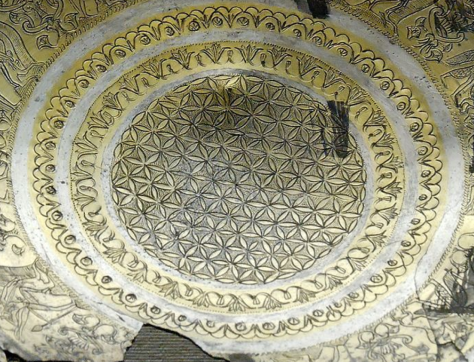
A cup with mythological scenes10 and the Flower of Life pattern in its center visible in the Louvre museum. Idalion, Cyprus, 800 – 700 BC. (Photo © Public Domain)
Oval pyxis
An oval pyxis11 with a base and a lid in the Iraq Museum, Baghdad. Nimrud, 800 – 700 BC. Note the object IM79513 that has similar, but badly cracked lid with the same geometric figure.
Terracotta torso
A Cypriot terracotta torso12 in the British Museum. Similar terracotta torsos with the FOL pattern are visible also in the Archaeological Museum of Lefkosia. Salamis, Greece, around 700 BC.
Ivory tusk
A carved ivory tusk13 in the Iraq Museum, Baghdad. Nimrud, 800 - 700 BC.
Ivory plague
A fragment of an ivory plaque14 in the Iraq Museum, Baghdad. Nimrud, 800 - 700 BC. Carving is noted by Wolfram Science15 as being characteristic form of ornament on Phoenician cultural period:
This was a common decorative pattern, formed by drawing circles centered at holes arranged in a triangular array. It is also found in Egyptian and other art.
Bronze vessel
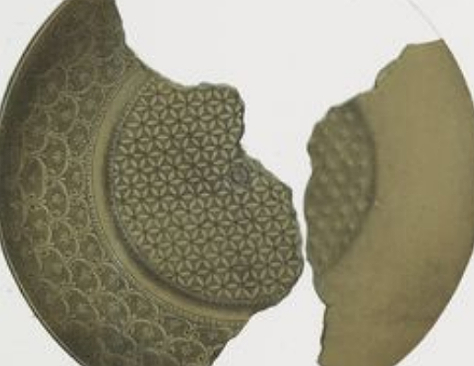
A bronze vessel16 from the palace of Sennacherib. New York public library. Iraq, Nimrud, 700 BC. (Photo © NYPL Digital Library)
Stone floor sill
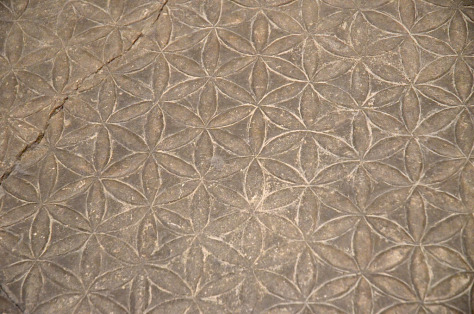
A stone floor sill with a field of interlocking circles decoration from the palace of King Ashurbanipal. Visible in the Museum of Louvre. Related objects are also visible in the British Museum (BM 11891017, BM 11891318). The Northern Iraq, 645 BC. (Photo © Marko Manninen)
Silver beaker
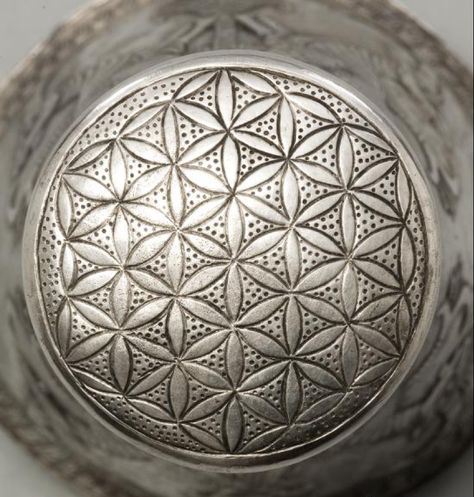
An ancient Near East silver beaker bottom motif, 600 – 500 BC. The object with one of the most precise work of FOL is in the Swedish Medelhavsmuseet19. Kind staff from the museum gave me this information:
The archived accession catalogue gives that it was received in 1980, probably through a certain O. Engkvist. There is also a comment in the margin: Prob Archaemenid, acc. To Vincent Pigott (Iran in the Near East), Prof pennsylvania, USA. Personal communication.
(Photo © Ove Kaneberg)
Cave arches

Chaitya arches in a form of wood lattice patterns, floral patterns, berm-rail arches and a parapet with Assyrian pattern20 of a row of stepped triangles in the Buddhist temple of Pitalkhora. Maharashtra, India, 200 – 100 BC. (Photo © Vivek S. Kale)
Opus signinum
Opus signinum21 (mosaic floor) of the Roman period house in the “city of charity”, Caminreal. Spain, 200 - 100 BC.
Floor mosaic at Ephesus
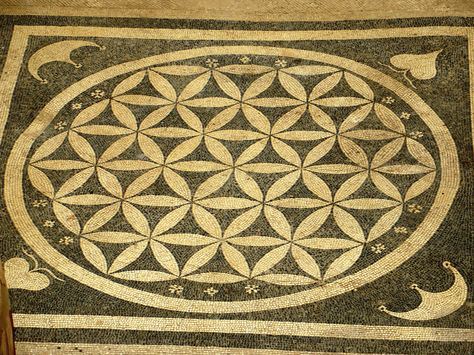
Floor mosaic on the house 1a on the Curetes Street, near the Library of Celsus in the archeological site of Ephesus, Turkey, 100 BC. This photo is used as a cover photo in this e-book. (Photo © Ken & Nyetta22)
Floor mosaic in Cyprus
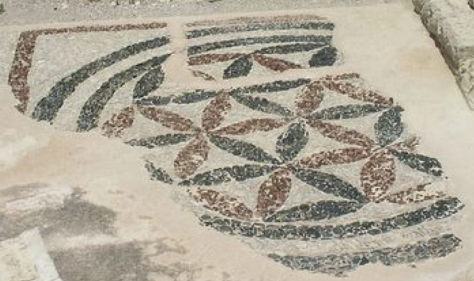
Mosaic floor ornament of the late Hellenistic period at Roman agora, the archeological site of Kourion in Cyprus. 75 – 50 BC. (Photo © Andrew Sweeney23)
Floor mosaic at Herodium
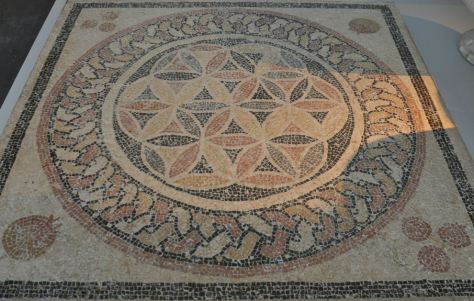
Floor mosaic in the bathhouse at Lower Herodium built by Herod the Great, unearthed and visible at the National Museum of Israel. Israel, 20 BC. (Photo © Shmuel Browns24)
- 6.1.1. metmuseum.org: Circular Cosmetic Box with a Swivel Lid
- 6.1.2. metmuseum.org: Cosmetic Box with a Swivel Top
- 6.1.3. louvre.fr: Gobelet orné de monstres ailés affrontés
- 6.1.4. dooroodiran: Marlik Culture
- 6.1.5.
- 6.1.6.
- 6.1.7.
- 6.1.8. britishmuseum.org: Spindle whorl
- 6.1.9. lacma.org: Bronze bowl
- 6.1.10. wikimedia.org: Cup Idalion Louvre
- 6.1.11.
- 6.1.12.
- 6.1.13.
- 6.1.14.
- 6.1.15.
- 6.1.16. nypl.org: Bronze vessels from Nimroud
- 6.1.17. britishmuseum.org: Door sill
- 6.1.18. britishmuseum.org: Door sill
- 6.1.19. smvk.se: Silver beaker
- 6.1.20. Grasp Gra: Buddhist temple of Pitalkhora
- 6.1.21.
- 6.1.22. Ken & Nyetta: Mosaic and Fresco from Hillhouses of Anciennt Ephesus
- 6.1.23. Andrew Sweeney: Kourion - Ancient Town
- 6.1.24. Shmuel Browns: Roman Bath House from Herodium